With our first metal miniature in our collection painted and
a number of Good and Evil plastic models to war with one another, it’s time to
expand our forces with some of the nastiest bad guys in Middle-Earth: the Uruk-hai.
They are the focus of Battle Games in
Middle-Earth #4.
As always, the magazine begins with “Guide to Middle-Earth.”
This issue’s entry describes the origins and characteristics of the dreaded
Uruk-hai. From their creation by Saruman to their unique ability among orcs to
function well in daylight, we learn the role the Uruk-hai play in the
machinations of Sauron and the Enemy’s plans for the Free People of
Middle-Earth. The Guide postulates a scenario where a force of elven scouts
from Rivendell encounter a band of Uruk-hai en route to Helm’s Deep and attempt
to prevent them from bolstering Saruman’s forces. This hypothetical event will
be further explored during the Battle Game chapter later in the issue.
Next up is “Playing the Game.” Last issue, we learned new
rules regarding the Priority and Move phase and how they impact the basic game
rules the magazine had taught us so far. Now it’s time to further delve into
the Fight phase and see what complexities exist for when forces clash in close
combat. This issue demonstrates the Wound Chart for the first time. In previous
battle games, the scores models needed to roll to wound an enemy were presented
for each figure. Here we now see the table used to determine these scores and
are told the means to calculate such numbers for ourselves (the winner’s Strength
cross-referenced with loser’s Defense). We learn that when these scores are
widely divergent, an attack might need to roll the dice twice on a strike,
achieving a 6 on the first die, than a 4, 5, or 6 on the second to cause a
wound. This came into play in the previous issue’s scenario and it’s now clear
exactly how bad
Frodo was outclassed by the Ringwraiths.
The methodology of breaking up complex battles into
bite-sized, easily-resolved combats is taught with clear photographs of models
to demonstrate the intricacies of such divisions. The rule for trapped models
is given; in situations where a model losing a fight cannot retreat the usual
2cm/1” required, the winner gains twice as many chances to inflict a wound.
This situation occurred in our very
first battle game so it’s nice to know how
to handle it now.
All these new rules and modifications are grouped with the
collected Fight phase rules presented in previous issues, giving the reader a “one-stop
shopping” chapter to reference during SBG matches.
The “Battle Game” chapter in this issue concerns a class
between a group of High Elves from Rivendell (the ones we assembled and painted
in issue #2) and a band of Uruk-hai. As previously noted, this scenario, “Elven
Attack,” is set shortly before the Battle of Helm’s Deep. It presents a
possible event where Elrond dispatched scouts to buy the men of Rohan more time
to rally their forces and these scouts engaged Uruk-hai headed to the
battlefield. The winning conditions require Good to slay at least six of the ten
Uruk-hai, while Evil needs to move five Uruk-hai off the opposite end of the
board. The scenario is an interesting one: The elves are slightly outnumbered
and the Uruk-hai are stronger, but the forces of Good are the only ones with
missile weapons. How it all turned out when we played through this battle will
be covered in a future post.
The “Painting Workshop” features techniques to paint our new
Uruk-hai troops. We’ve come a long way from our efforts with the
Moria Goblins
back in Battle Games in Middle-Earth #1. By now, we’ve learned how to mix
paints to achieve different colors aside from the seven paint pots we own
(assuming we’ve been relying solely on those included with each issue of the
magazine), how to drybrush models, and how to use flock or static grass as a
simple basing technique. We add a new trick to our repertoire this time around:
“silver edging.” This gives metal weapons and armor a sharp and menacing look, something
no Uruk-hai should be without!
We now come to our final chapter, “Modelling Workshop.” This
issue it’s time to rise above the tabletop as we learn how to fashion simple
hills for our SBG and other miniature wargames. The steps to create polystyrene
hills are presented in clear, easy-to-follow steps, allowing even the most
ham-handed tabletop wargamer to make any number of grassy hills to adorn the
battle board for a fraction of what commercially manufactured ones cost.
Looking to the back cover, we see that another metal model,
the Uruk-hai captain, Lurtz, will be arriving in two weeks, providing us with
another hero (albeit an Evil one) to add to our collection. With our squad of
Uruk-hai awaiting his arrival and orders, what hope do the forces of Good have?
We’ll see in the weeks ahead!
Next up, let’s paint some orc.




















































